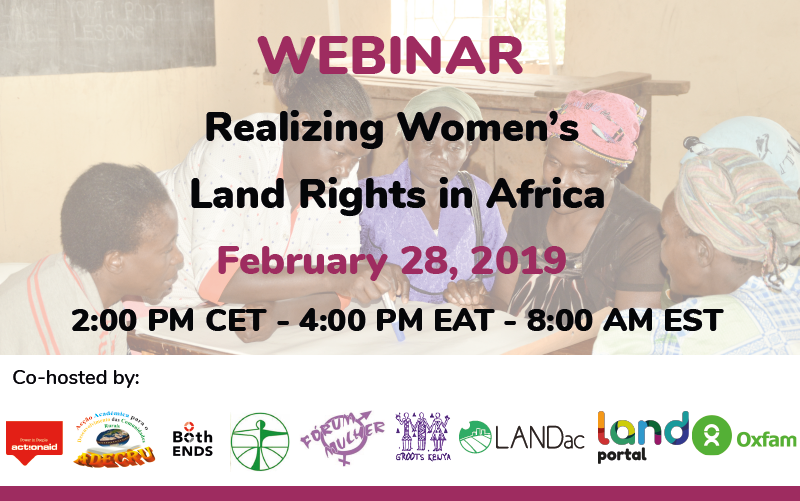Griet Steel (Utrecht University and LANDac, the Netherlands).
It is my pleasure to welcome you to this timely and important webinar on Realizing women’s land rights in Africa and beyond, which is co-hosted by Acção Académica Para O Desenvolvimento Das Comunidades Rurai (ADECRU) (Mozambique), Action Aid, Both ENDS, ENDA Pronat (Senegal), Fórum Mulher (Mozambique), GROOTS Kenya, LANDac, the Land Portal Foundation and OXFAM. It is my honor to moderate this discussion.
I am Griet Steel, assistant professor at Utrecht University (department of human geography and planning) and as research coordinator of LANDac, the Netherlands Land Academy, I have led a year long action research programme on Women’s Land Rights in Africa. With this webinar we want reflect on some of the key lessons and messages of the programme and look how we can strengthen women’s land right in Africa but also in other continents and countries across the globe.
We therefore would like to welcome four panelists from different civil society organizations and grassroots movements. On the basis of their day to day work in the field, they will reflect on how they fight for women’s improved access to and control over land and other natural resources and to scale up women’s land rights.
Allow me to introduce our esteemed panelists:
- Nzira Razão Deus. Nzira is the executive director from Fórum Mulher in Mozambique a civil society organization that for years has been working on gender equality and rural rights in rural communities across Mozambique. For the Women Land Rights programme they have teamed-up with ADECRU another oc-organizer of this webinar. As a human rights activist and member of the feminist movement, Nzira has advocated for the human rights of women and girls regarding violence, the economy, political participation, and sexual and reproductive health.
- El Hadji Faye programme coordinator of Enda Pronat, Senegal a civil society organization experimenting with agro-ecological alternatives that reduce the use of pesticide and strengthen the position of rural families. As the project manager of Enda Pronat Elhadji has worked around questions on tenure security, agricultural politics and agro-ecology in general. His day to day work is in French and Wolof so this is why we would like to also welcome his colleague Marina who will help out with translation in English in case needed.
- Fridah Githuku is the Executive Director of GROOTS Kenya. GROOTS Kenya is a network of Women-Led community organizations in Kenya. It formed as a response to inadequate visibility of grassroots women in development and decision-making forums that directly impact them and their communities. Fridah works with with grassroots women and girls in 17 counties and started programmes that have seen many women become successful lead farmers, landowners and leaders at the grassroots, including members of land boards.
- Sreetama Gupta Bhaya from works with Oxfam India. She has 16 years of experience on issues of governance of natural resource, rights & livelihood -primarily with tribal communities in India . She has worked with national and international NGOs, with Government of India, on policy & advocacy related to tribal rights and livelihood. . She will speak on women rights in the context of natural resources and the advocates for the importance of collective rights and how these enable a space for women to negotiate.
In the next hour these four panelists will be asked one by one to look at the bottlenecks of women’s land rights and why it remains an important issue to focus on, as well as questions on their experiences and good practices to improve the situation on the ground and what will be further needed to scale up these approaches. After the first hour we will open the discussion and give room to the participants to add questions. Please use the questions feature to pose questions to the panelists. We will ensure that your questions are addressed in turn during the open discussion that follows.






